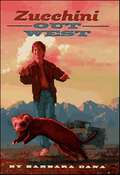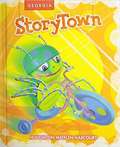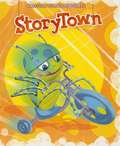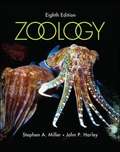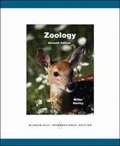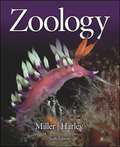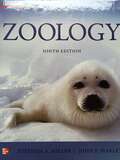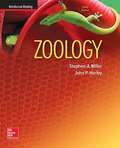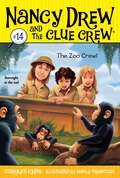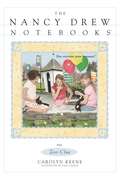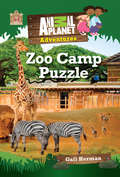- Table View
- List View
¡ZUM! La historia del snowboard (¡Arriba la Lectura!, Level M #72)
by Lisa TrumbauerSi te gusta la nieve, tal vez te guste practicar snowboard. ¡Lee sobre este divertido deporte! NIMAC-sourced textbook
Zucchini Out West (Zucchini Ser. #2)
by Barbara DanaZucchini is Billy's pet and his best friend. When biologists at the ASPCA think that Zucchini is a rare black-footed ferret, Billy is in a quandary. He loves animals and does everything he can to help the ecology, but realizes that he can't keep an endangered animal as a pet. Can Billy do the right thing and risk losing Zucchini forever?
El zorro y la cigüeña (¡Arriba la Lectura!, Level H #60)
by Annette Smith Tamsin HinrichsenEl zorro le hace una broma a su amiga la cigüeña. Pero la cigüeña le enseña al zorro algo sobre la amistad. NIMAC-sourced textbook
Zooming to Zaragon (Fountas & Pinnell Classroom, Guided Reading Grade 4)
by Linda Dunlap Kim HerbstLenora never imagined she'd ever meet a being from another planet. But Zikon seems far more nervous about the encounter than she does - and needs her help. NIMAC-sourced textbook
Zoom Along (Level 1-2, Georgia student edition)
by Isabel L. Beck Roger C. Farr Dorothy S. StricklandNIMAC-sourced textbook
Zoom Along (Level 1-2, Florida student edition)
by Isabel L. Beck Roger C. Farr Dorothy S. StricklandNIMAC-sourced textbook
Zoology (Eighth Edition)
by Stephen A. Miller Harley John P. HarleyThe 8th edition of Zoology continues to offer students an introductory general zoology text that is manageable in size and adaptable to a variety of course formats. It is a principles-oriented text written for the non-majors or the combined course, presented at the freshman and sophomore level. Zoology is organized into three parts. Part One covers the common life processes, including cell and tissue structure and function, the genetic basis of evolution, and the evolutionary and ecological principles that unify all life. Part Two is the survey of protists and animals, emphasizing evolutionary and ecological relationships, aspects of animal organization that unite major animal phyla, and animal adaptations. Part Three covers animal form and function using a comparative approach. This approach includes descriptions and full-color artwork that depict evolutionary changes in the structure and function of selected organ systems.
Zoology 7th Edition
by Stephen A. Miller John P. HarleyThis is a principles-oriented introductory zoology text for non-majors or combined majors/non-majors (freshman-sophomore level). The emphasis is on basic concepts at the most accessible level for students with no science background.
Zoology (6th Edition)
by Stephen A. Miller John P. HarleyThe textbook is organized into three parts. Part One covers the common life processes, including cell and tissue structure and function, the genetic basis of evolution, and the evolutionary and ecological principles that unify all life. Part Two is the survey of protists and animals, emphasizing evolutionary and ecological relationships, aspects of animal organization that unite major animal phyla, and animal adaptations. Part Three covers animal form and function using a comparative approach.
Zoology (3rd Ed.)
by Stephen A. Miller John P. HarleyThe new 7th edition of "Zoology" continues to offer students an introductory general zoology text that is manageable in size and adaptable to a variety of course formats. It is a principles-oriented text written for the non-majors or the combined course, presented at the freshman and sophomore level. "Zoology" is organized into three parts. Part One covers the common life processes, including cell and tissue structure and function, the genetic basis of evolution, and the evolutionary and ecological principles that unify all life. Part Two is the survey of protists and animals, emphasizing evolutionary and ecological relationships, aspects of animal organization that unite major animal phyla, and animal adaptations. Part Three covers animal form and function using a comparative approach. This approach includes descriptions and full-color artwork that depict evolutionary changes in the structure and function of selected organ systems.
Zoology
by Stephen A. Miller John P. HarleyThe new 7th edition of "Zoology" continues to offer students an introductory general zoology text that is manageable in size and adaptable to a variety of course formats. It is a principles-oriented text written for the non-majors or the combined course, presented at the freshman and sophomore level. "Zoology" is organized into three parts. Part One covers the common life processes, including cell and tissue structure and function, the genetic basis of evolution, and the evolutionary and ecological principles that unify all life. Part Two is the survey of protists and animals, emphasizing evolutionary and ecological relationships, aspects of animal organization that unite major animal phyla, and animal adaptations. Part Three covers animal form and function using a comparative approach. This approach includes descriptions and full-color artwork that depict evolutionary changes in the structure and function of selected organ systems.
Zoology
by Stephen A. Miller John P. HarleyThe new 7th edition of "Zoology" continues to offer students an introductory general zoology text that is manageable in size and adaptable to a variety of course formats. It is a principles-oriented text written for the non-majors or the combined course, presented at the freshman and sophomore level. "Zoology" is organized into three parts. Part One covers the common life processes, including cell and tissue structure and function, the genetic basis of evolution, and the evolutionary and ecological principles that unify all life. Part Two is the survey of protists and animals, emphasizing evolutionary and ecological relationships, aspects of animal organization that unite major animal phyla, and animal adaptations. Part Three covers animal form and function using a comparative approach. This approach includes descriptions and full-color artwork that depict evolutionary changes in the structure and function of selected organ systems.
The Zookeeper (Fountas & Pinnell Classroom, Guided Reading)
by Jesse JamesNIMAC-sourced textbook. Lunch Time at the Zoo. The zookeeper feeds the animals at the zoo. Each animal gets something different.
ZooBorns!: Zoo Babies From Around The World (Elementary Core Reading)
by Andrew Bleiman Chris EastlandNIMAC-sourced textbook
The Zoo Crew (Nancy Drew and the Clue Crew #14)
by Carolyn KeeneThis camp is WILD! Nancy, George, and Bess are attending a three-day overnight camp at the local zoo. They'll get to spend lots of time with all of the animals and learn about them too. The best part is, they will be helping the zookeeper make toys for the animals -- just like real staffers! But when the toys the girls make by day are disappearing at night, it looks like everyone is a suspect! Can Nancy tame this wild case, or will the zoo animals be without anything fun to do?
Zoo Clue (The Nancy Drew Notebooks #66)
by Jan Naimo Jones Michael Frost Carolyn KeeneNancy and her friends are on a class trip to the zoo. Everyone brought a camera and is excited because their teacher has announced a Best Photo contest. Whoever takes the best picture at the zoo wins a prize! The trip is going great--until a flowerbed outside the monkey cage is wrecked and Nancy's class is blamed! The zookeeper is mad and says they might have to leave the zoo if someone doesn't come forward. Nancy is upset. Is one of Nancy's classmates a crook, or is someone else digging up trouble?
Zoo Camp Puzzle (Animal Planet Adventures Chapter Books #4)
by Gail Herman Animal PlanetNine-year-old twins Ava and Rosie are headed for adventure. City kids, they don't know what to expect from a small zoo in Iowa-and they have to live there for the rest of the year while their mom writes a book! Being away from the busy city and their friends feels like punishment, but Dad sets up a project for them all-running a zoo camp for students to attend during spring break. That could be cool, but as they're getting ready, the kids realize that some of the animals are missing! They'll have to solve the mystery-fast-before the campers arrive.Perfect for reluctant, challenged, and newly fluent readers, the Animal Planet Adventures chapter book series combines fun animal mysteries with cool nonfiction sidebars that relate to the stories, bringing the best of the animal world to young readers. With full-color illustrations and photographs throughout.Collect all of the Animal Planet Adventures books, including Amy and Elliott's story Puppy Rescue Riddle.

